|
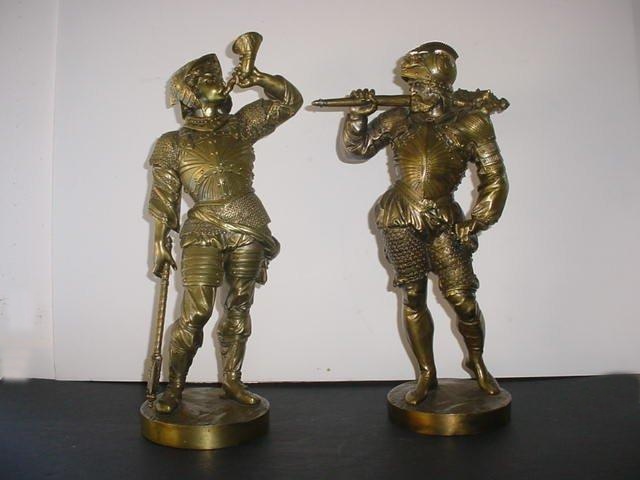
|
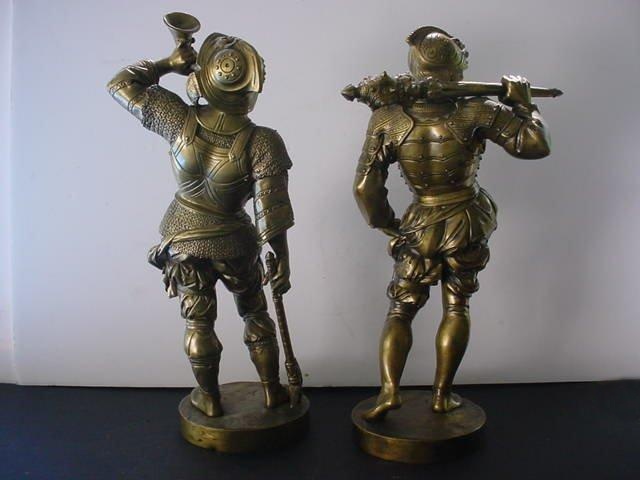
|
|
Pair of Exquisite Bronze Statues of Landsknechte (Item BRONZEMET 3-1; LAND 2-3)
|
DESCRIPTION: Here is a beautiful statuary group depicting two rough-and-ready mercenary soldiers known as Landsknechte.
For a further explanation of the term see the heading at our Landsknechte page at the top. These bold fighters usually wore colorful attire with flashing colors in the finest of fabric, but as they were the ultimate fighting men of their day the battle clothing changed from time to time as required by conditions, and also changed, depending on which king or noble lord they served and his requirements they conformed to. The two Landsknechte depicted here are in full armor—at least in the upper body. The helmets were of the style used by Soldaten who were in the employ of royalty or at least very wealthy landed gentry. Helmets such as this were extremely expensive in that era and both look to be the type crafted by metal masters in Italy. One man carries one of the most formidable weapons used by the mercenaries; a huge mace with its business end studded with sharp nail points. The other has a sword and he sounds a call to battle on his horn. The Landsknechte were proud fighting men and a very colorful lot having left behind a rich although bloody tradition. They had a series of battle ballads some of which are cataloged in German and Swiss archival records today. Some of their songs were sung by the storm troopers of the Third Reich; both Brown Shirts and army and Waffen- troops as they marched off to war. The sculptures are of pure bronze with a golden hue; they measure 16 ½ inches high and are quite heavy. The sculptures are not signed but are of the finest of quality. They must have been accomplished by a master sculptor who might have been so famous in his time that he felt his work was his signature alone. Imagine these stalwart battle-hardened fellows on your shelf or desk. They will surely be a statement of determination and will. troops as they marched off to war. The sculptures are of pure bronze with a golden hue; they measure 16 ½ inches high and are quite heavy. The sculptures are not signed but are of the finest of quality. They must have been accomplished by a master sculptor who might have been so famous in his time that he felt his work was his signature alone. Imagine these stalwart battle-hardened fellows on your shelf or desk. They will surely be a statement of determination and will.
PRICE: $2,500.00 for the set
|
|
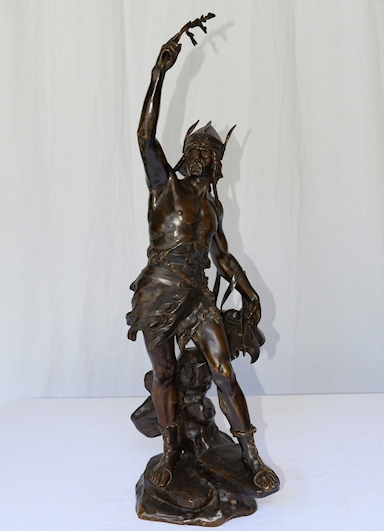
|
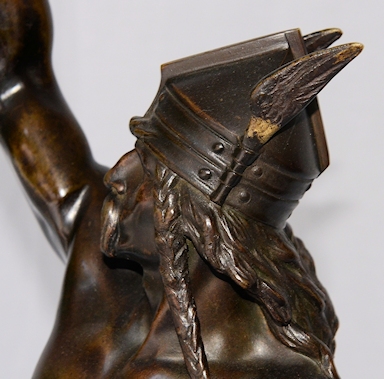
|
|
The Gaulish Chief Vercingetorix with the Sign of Unity, by Edouard Drouot (Item BRONZEMET 3-2)
|
|
DESCRIPTION: Here is the famed Vercingetorix, the chief of the Arverni tribe who united the Gauls in an unsuccessful revolt against Caesar in 52 B.C.
Caesar had almost completed the subjugation of Gaul when Vercingetorix led a general uprising against him. After an initial defeat in early battle, Vercingetorix used guerilla warfare to harass Caesar’s supply lines and cleverly offered to engage the Roman forces on terrain unfavorable to them. He successfully held the Arvernian hill-fort of Gergovia against an assault by Caesar. Vercingetorix followed this victory by an attack on the Roman army, the failure of which compelled him to retreat with 80,000 troops to the prepared fortress of Alesia (in east-central France). Caesar, with 60,000 men, laid siege to the fortress and was able to force its surrender after he had defeated the Gaul’s reserve army in the field. Brave Vercingetorix was taken to Rome in chains, exhibited in Caesar’s triumph and executed six years later. When Caesar wrote The Gallic Wars, he said of Vercingetorix, “Himself a man of boundless energy, he terrorized [his own and the enemy] with the rigors of an iron discipline.”
The statue stands 30 inches high from the bottom of the base to the top of his helmet, but to the top of the laurel branch it is 30 inches. The meaning of the uplifted branch of laurel is this: In order that the Germanic tribes of the Arveni and the other Gauls would be able to resist the Roman Legions they would have to be able to come together in unity, much as Hermann the Liberator brought the tribes together for the great Germanic victory in the Teutoberg Forest against the Romans.
Now it was entirely incumbent on Vercingetorix to do the same.
Up to this point the various tribes of the Gauls and other clans were constantly in petty squabbles against one another, but now it was a case of either to prevail militarily or lose and go right into Roman bondage. So, Vercingetorix would be the man of the hour! He went to the tribal councils each time with the upraised laurel as a sign of unity, and he sat with the elders and convinced them of his position and whatever emergency that had arisen thereby successfully gaining their full support. The statue is beautifully detailed with a wonderful bronze patina. It’s signed by the master sculptor Edouard Drouot, 1859-1945, and bears the stamp of the Paris Foundry.
Drouot had a penchant for depicting hunting scenes, exotic eastern subjects, mythological figures, nymphs, and important historical scenes and personages such as the one we offer here. He produced a myriad of fine collectible sculptures that were cast to absolute perfection and he commanded and demanded top quality of his founders. It’s estimated that his bronze editions number no less than five hundred.
His men are rugged and strong featured. Women are well proportioned and beautiful. The style Drouot set never really changed over his sixty-five year career. Harold Berman’s four volume set of books Sculptors and Founders (1800-1930) show numerous Drouot sculptures. This one, however, must be considered quite rare as it is not included in the cataloged works. We feel it was a very special edition. It is said of this sculptor that he loved the fluidity of the Art Nouveau movements in his portrayals, and, he had a recurrent ability to arrest movement and expression with a definite touch of genius. This figure possesses all those features to the height of perfection.
The figure shows the accurate dress of the Gaulish warrior chief: his typical winged helmet, the braided hair style, the wide girdle, the great war ax and shield. Here is a dramatic historical subject beautifully depicted and very rare and exciting.
PRICE: $6,950.00
|
|
|
|
|
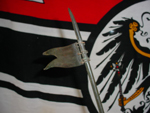
The lance |
|
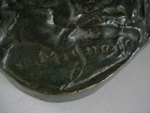
The signature |
|
|
|
|
|
|
|
|
|
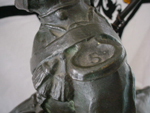
Note: 5th Uhlan boards |
|
Massive Equestrian Bronze Statue of the 5th Regiment Prussian Uhlans(Item BRONZEMET 3-3; WWI 12-15; KSTATUE 5-16) |
DESCRIPTION: This is a magnificent bronze depiction of a mounted horseman of the Fifth Uhlan Regiment of the Kaisers 3rd Cavalry Division attached to the First German Army Command. They served with particular distinction in the Franco Prussian war and WW1. Uhlans were light cavalry, actually Lancers, who fought with carbines, swords, and lances. The title Uhlan was used by Lancer regiments in the Russian, Austrian and especially the Prussian armies. Uhlans typically wore a double buttoned tunic (Kurta) with a colored panel at the front, a colored sash and a square topped Lancer cap (Czapka), also spelled chapka. This cap was originally derived from a traditional design of the Polish civilian cap made more formal and stylized for military use. Their Lances usually had small swallow tail pennants known as the Lance Pennon that was found just below the spearhead (see our pictures). Prussian Uhlans distinguished themselves and fought bravely in the war against Napoleon. In WW1 the Imperial German Army included 26 Uhlan regiments. They all saw action while on duty at the first part of the war and their charge with lances struck fear in the hearts of the enemy since it has well been known that these were formidable warriors adept at warfare (up front and personal!). Later in the second year of the war the Uhlan regiments were either dismounted to serve as cavalry rifle regiments in the trenches of the western front or transferred to the eastern front where primitive conditions made it still possible for horse cavalry to play an effective role. In WWII a popular myth is that Polish cavalry armed with lances charged and were annihilated by German tanks during the 1939 campaign; this arose from the misreporting (both intentional and unintentional) of the charge at Krojanty on 1 September when two squadrons of Polish 18th Lancers armed with lances and sabers were met in combat by German cavalry led by Harry Von Johnston in what was the last charge of German cavalry with sabre. The Poles were dispersed and defeated by Germans who rode one last time in the spirit of the Old Prussian Uhlans. This is a little known fact of history that for the most part has remained hidden for all these years.
The bronze statue is accurate in every detail and prodigiously dramatic in its heroic depiction. It is a huge and heavy sculpture done in the finest mode of German bronze art. It measures 26 inches high from the bottom of the base to the top of the Uhlan Czapka. The horse is 22 inches long from tail to muzzle. The base is measured at 19 ½ x 7 inches. The sculpture is signed by Leon Mignon (1847-1898), a sculptor from Brussels, Belgium. He studied under the sculptor Prosper Drion (1822–1906) at the Académie in Liège from 1857 to 1871. He was a particular admirer of the anecdotal sculpture of Léopold Harzé (1831–1893). His vocation as a sculptor of animal subjects began in Rome, where he studied on a grant from 1872 to 1876. He exhibited in Ghent (1874) and on several occasions in Paris (where he lived from 1876 to 1882) at the Salon des Artistes Français. He achieved prominence at the exposition Universelle of 1878 in Paris with his bulls fighting in the Roman countryside (Brussels, mus. a. mod.). In 1880–81, he shared a studio with the Belgian sculptor Paul DeVigne, whom he had met in Rome. Mignon’s bull tamer (liège, parc avroy) took the gold medal at the Salon of 1880. In 1882 he settled in Brussels and in 1888 produced the labors of Hercules reliefs for the stairway of the palace of Charles de Lorraine (now part of the Bibliothèque Royale Albertier). He sculpted several historical figures for the provincial law courts and was an astute philosopher of his time. In 1892 he sculpted many subjects for the Université de Liège. He excelled as a sculptor of animal subjects. Mignon occupies a leading place in Belgian realist art. He also modeled busts of Belgian personalities as well as a statuette of the Belgian painter Hubert Bellis; figurines of workers, soldiers from the Belgian regiments (c. 1889), and even an equestrian statue of a Prussian Uhlan, France’s enemy in the 1870 war; and a statue of Leopold in 1886 ( Brussels, mus. a. mod.). His works are preserved in the Musée de l’art Wallon, Liège, and the Musée d’Art Moderne, Brussels. He was completing a frieze for the Hôtel Somzée in Brussels when he died unexpectedly. He was an amazing artist and a cultured man of vision. A grand museum grade art piece personified and extraordinaire! It is priced under market value for a sculpture as fine as this one is. It is certain that one could not find any such dramatic artistic accomplishment to rival this one. Here he is! In all his Imperial glory. Listen as you view him and perhaps, just perhaps, you will hear the strains of “Heil Dir im Seigerkranz” (Hail to thee in Victors Crown.) Deutschlands Helden Lebt in ewig leben!
PRICE: SOLD |
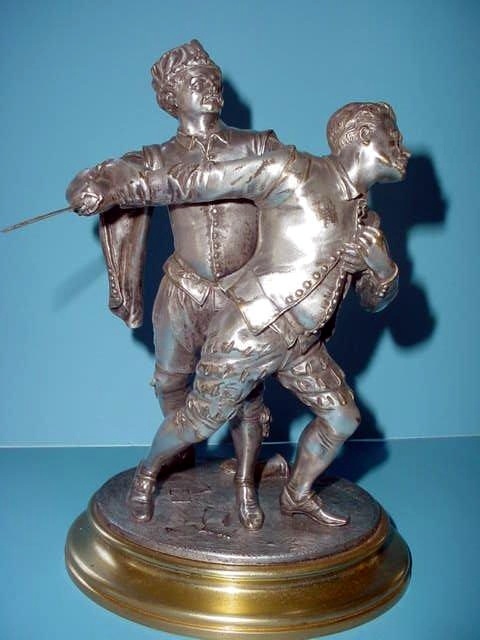
|
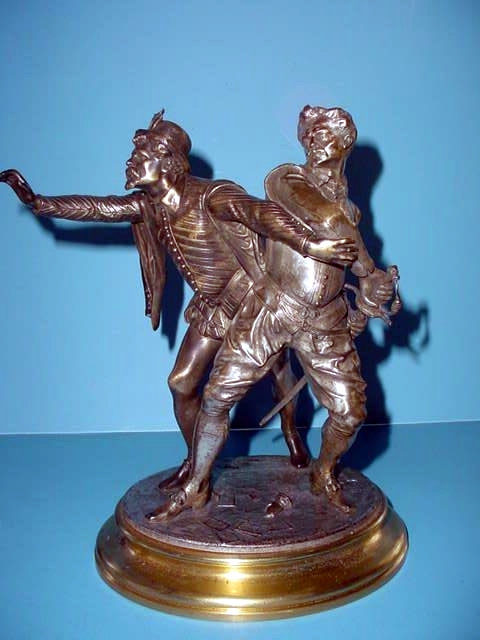
|
|
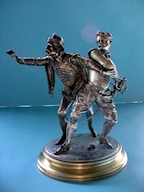
|
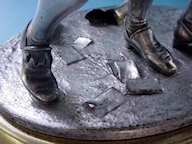
Note the playing cards
|
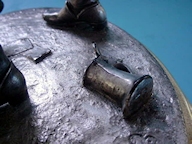
|
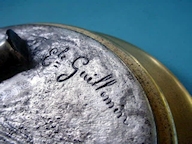
Artist's signature
|
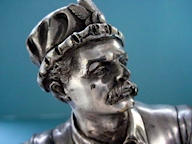
|
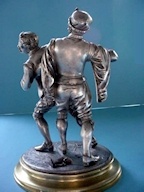
|
|
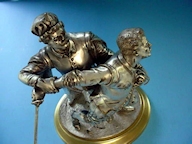
|
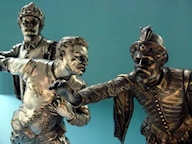
|
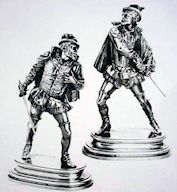
Other groupings by this artist
|

From Berman's book
|
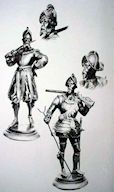
More groupings from this artist
|
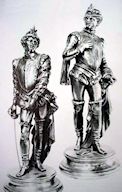
|
|
“The Duelists” by Guillemin (Item BRONZEMET 3-4)
|
|
DESCRIPTION: Here is a pair of sculptures by one of the greatest sculptors of France, Émile Guillemin (1841-1907). Paris-born Guillemin was best known for these lively, small-scale cavaliers and conquistadors—often in conflict. His lifelike biblical heroes: Judith, Rebecca, David and Goliath are nothing short of extraordinary as are his ravishing Turkish dancing girls. Accurate costuming, minute detailing, expressive faces, and top French foundry work typify his sculptures; interestingly some of his finest pieces were not signed. The group we offer here are among the “best of the best!” I have said his specialty was the action figures of cavaliers and here is one of the twosome sets that were his outstanding masterpieces.
We show pictures of others from the hornbook on bronzes that is mentioned further on in this descriptive narrative.
This set depicts two cavaliers who have had a violent disagreement that has led to an impromptu duel that would surely lead to death were it not for the intervention of both of their friends. Their short tempers are ignited over a card game where it is assumed that that one chap has accused the other of cheating. The evidence of the ensuing “donnybrook” is clear if you look at the floor where the debris of an overturned gaming table is evident and there at their feet is a beer or wine pitcher, playing cards, a broken flagon, etc., points out evidence of the sudden fiery confrontation. The cavalier on the left has his sword already drawn and attempts to lunge with it toward the other cavalier, who is in the act of drawing his weapon. Meanwhile the shocked friends, who are also cavaliers, are doing their level best to stop the mayhem that is beginning and surely will end with the death of one of the would-be combatants. The action is profound and realistic to the greatest degree and the scene is fantastically exciting; the facial expressions capture all the real emotion that would have been experienced in a scenario of impending doom such as this.
The sculpture is one of two of this subject. We picture the other figures by Guillemin that can be seen in the books by Harold Berman on page 396, figures 1470 and 1471, in the set of books entitled Bronzes: Sculptors & Founders, 1800-1930, Volume Two. These dueling cavaliers are utterly great, and by the greatest sculptor of action bronzes; we have included about 20 views of the wonderful detail. We have never seen bronze sculptures that depict a historical incident so artistically perfect. The figures are in A-1 perfect condition with some discoloration in the old silver plating, but this not only does not detract, but actually gives an elegant and quality highlight to the scene. This is a superb and prodigiously important sculptor. The figures are about 9 inches high and their bases are about 5 inches across.
Magnifique!!!
PRICE: $3,850.00
|
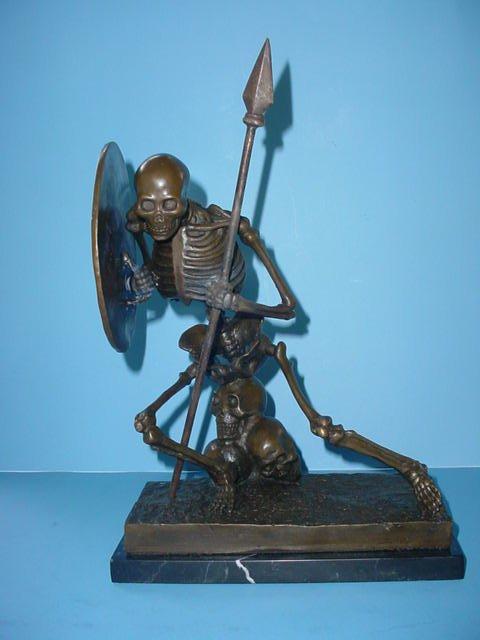
|
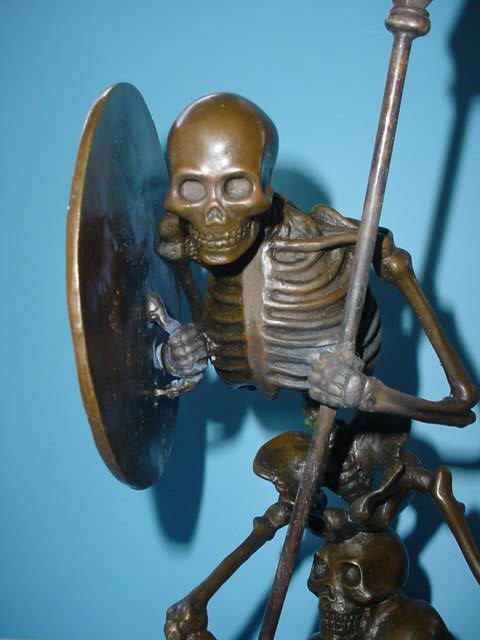
|
|
Skeleton Warrior (Item BRONZEMET 3-5)
|
|
DESCRIPTION: Here is a strange and eerie figure in bronze of a skeleton, who holds a lance and shield right from the under reaches of hades. If you ever saw the epic film Jason and the Argonauts you must remember the classic scene where Jason has to battle the children of the Hydra, who sprung from the ground as skeleton warriors germinated from her teeth planted by his pursuer. This figure that stands about a foot high—not counting his spear—looks just like those ghostly fighters of the Underworld. The marble base measures 9 ½ x 5 inches. The anatomical structure of the figure is very realistic and the pose prodigiously dramatic. The shield has the image of the demonic tribal coven that he comes from, evidently. This would be a great desk ornament for a lawyer, bill collector, IRS agent, or maybe a chiropractor!
PRICE: SOLD
|
|
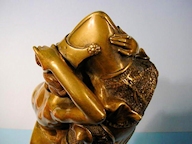
|
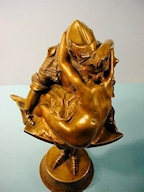
|
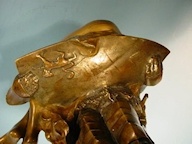
The front of the shield
|
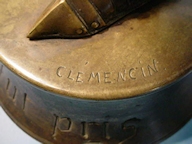
Artist's signature
|
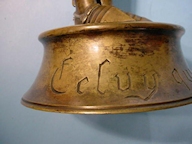
|
|
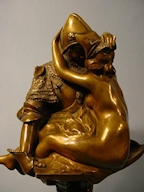
|
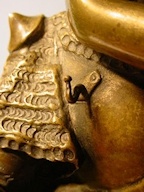
The jousting hook device
|
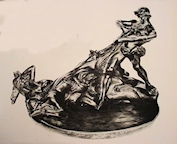
Other bronzes by this artist
|
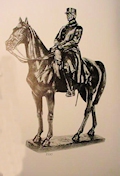
|
|
Bronze of a Chivalrous Knight with his “Special Prize” (Item BRONZEMET 3-6)
|
|
DESCRIPTION: Here is a great bronze statue depicting the knight who was the winner of a jousting contest with “first prize” and “what a prize”! The intriguing group is by famed French sculptor François-André Clemencin (1878-1950). On the base of the statue it says Celui Qui Fut Pris (“Whoever was caught”). It is in full genuine bronze and has a fine bronze patina. Height 15 inches, or 38 cm. The sculptor probably did the work about 1908. If you look closely at the pictures you can see the devise on the knight’s armor for securing the jousting lance. The work is signed “Clemencin,” who uses only his last name. Although the sculpture is rather whimsical the sword and armor is quite accurate. Clemencin was an artist of note and is mentioned in several hornbooks on sculptured art including a biography in Pierre Kjellberg’s Bronzes of the 19TH Century. The piece is in great condition overall, but missing one spur off his armored foot. To the victor goes the prize!
PRICE: $4,300.00
|
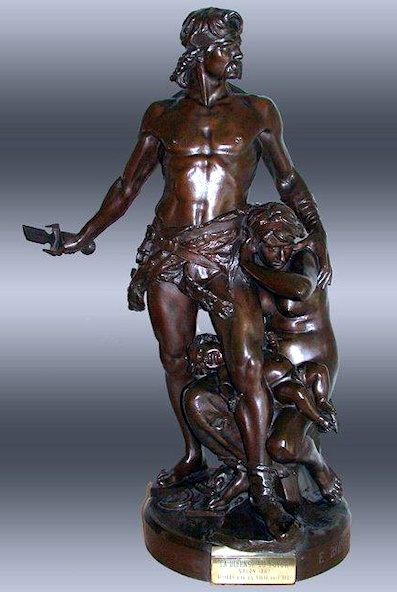
La Défense du Foyer - “Defense of the Home”
|
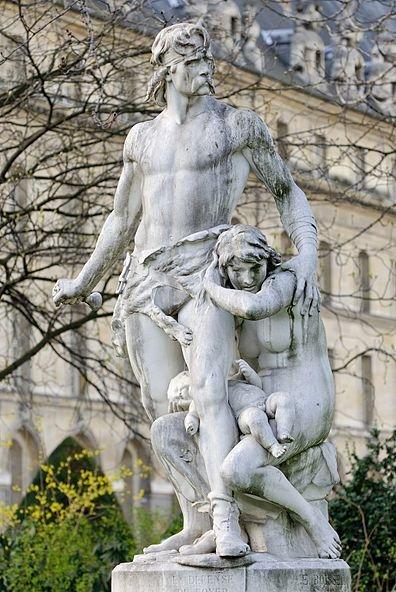
Here is the statue by E. Boisseau that stands
in the Square d’Ajaccio in Paris
|
|
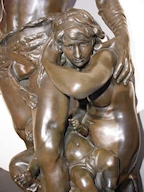
|
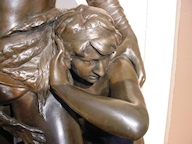
|
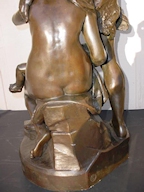
|
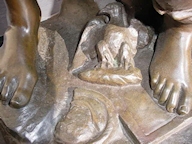
The Roman standard
|
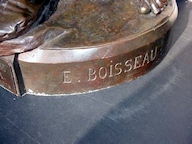
The artist's signature
|
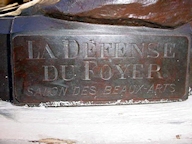
|
|
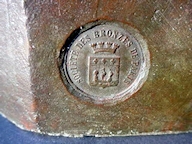
The Paris foundry seal
|
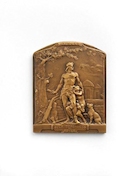
The plaque by Boisseau
|

Another sculpture by Boisseau
|

Another sculpture by Boisseau,
but in granite or porcelain
|
|
Monumental Statue in Bronze “Defense of the Home” (La Défense du Foyer) (Item BRONZEMET 3-7)
|
DESCRIPTION: Here is the most impressive and meaningful bronze sculpture that we have ever offered. The subject was sculpted by French artist Emile-André Boisseau (1842-1923). The subject was immortalized in this sculpture and a bronze plaque, plus a fully twice life-sized statue in stone that stands in Paris in Ajaccio Park known as Defense Square. The subject is a brave Germanic warrior who stands defiant in battle to protect his home and family from the enemy. We believe he is a Teutonic warrior because at his feet lies the broken eagle standard of Rome. The French sculptors were absolutely fascinated by the historic saga of Die Schlacht im Teutoburger Wald (The Battle of the Teutoburg Forest) where Hermann, the Cherusci chieftain, also known as Arminus, soundly defeated three Roman legions along with their auxiliaries led by Publius Quinctilius Varus. To learn more about this epic battle, go to Google (Wikipedia). Also see our featured china plate on the Old Reich section of our pages at OLD 3-2. Also see OLD 7-2. The foundry mark on the sculpture is from the Paris Society of Bronzes. The statue is seen as image 1124 in Bronzes : Sculptors and Founders, 1800-1930 Vol. II by Harold Berman. The base bears the artist’s name and the inscription “Salon des Beaux-Arts” (Gallery of Fine Art). This was the term under which two groups of French artists united; the first, for exhibitions in the early 1860s; the second, since 1890 for annual exhibitions of the best in paintings and sculpture. This particular piece would certainly be ranked as one of the best of the age. The statue stands about 35 inches high with a base 15 inches in diameter. It is very heavy. The subject is both heroic with the defiant warrior, but also sentimental with his wife and baby so frightened, but confident in the fierce determination of their man to protect them from the cruel enemy. This has been the way of the warrior from time immemorial. Boisseau has never portrayed the theme as art in a fashion so loving as in this sculpture he created in 1915. The sculpture has been said to represent in visual terms Marshal Joseph Joffre’s* rallying call in 1914 to the soldiers of France to die where thy stood rather than to give way. It represents a vulnerable civilian population protected from the enemy by the sheer valor of its fighting men. Bousseau’s sculpture dates from 1915, when French propaganda still promulgated the possibility of an early glorious victory before the reality of the disastrous war struck home to a wider public. All of that being said, it is still evident that Boisseau had in the recess of his mind the Battle of the Teutoburg Forest if evidenced only by the broken Roman standard cast upon the ground. Was this French wartime propaganda or a statement about the defense of the Aryan culture group and its peoples? Maybe a bit of both? In any case, it stands as a symbol of the strength and resolve of men of the West who, in the fray, will stand for family, nation, and principles. Let this wonderful work of art be a permanent reminder of that noble calling: Forever and ever the cause we’ll uphold; the cause of the true; and the trusted and bold.
*Marshal Joseph Jacques Césaire Joffre was a French general during WW I. He is best known for regrouping the retreating Allied armies to defeat the Germans at the strategically decisive First Battle for the Marne in 1914. His popularity led to his nickname “Papa Joffre.”
PRICE: $16,000.00
|
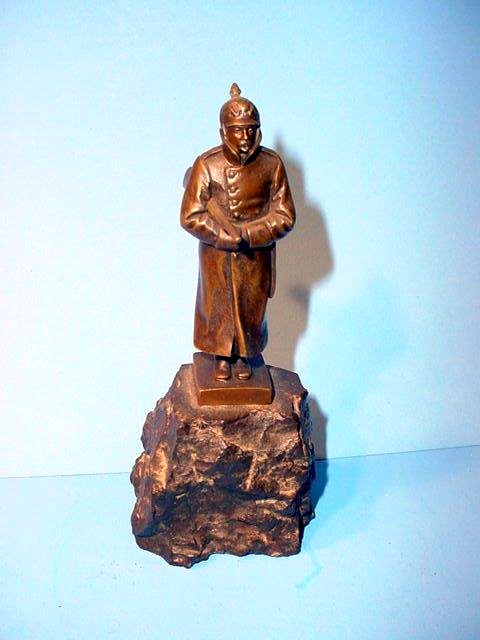
|
|
Petite German WWI Soldier in Bronze with
Pickelhaube and Rifle
(Item BRONZEMET 3-9)
|
DESCRIPTION: This is a really niece little bronze sculpture that is a little re-creation of a statue that stood on the banks of the northern Rhine River near Duisburg. There was in the 1800s a poem that was in American school journals, but then that was before the media propagandists turned the American population into haters against their own European kith and kin. The poem went:
“Steadfast and true these sons of thine as they stand watch upon our noble Rhine!”
The rest of it slips my mind. Fest steht und treu die Wacht, die Wacht am Rhein! The statue had the same name as the famed German patriotic song Die Wacht am Rhein (Watch on the Rhine). The sculpture with the rock he stands upon is about 7 or 7 ½ inches tall. He is depicted in the winter season as evidenced by his overcoat. He wears the Pickelhaube or spike helmet with the all-season helmet cover. This is an original period sculpture and a very dramatic and romantic sculpture from the days of Germany’s glory.
PRICE: $285.00
|
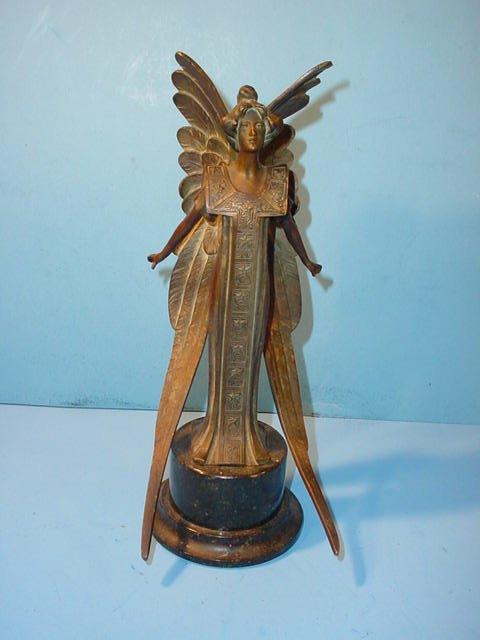
|
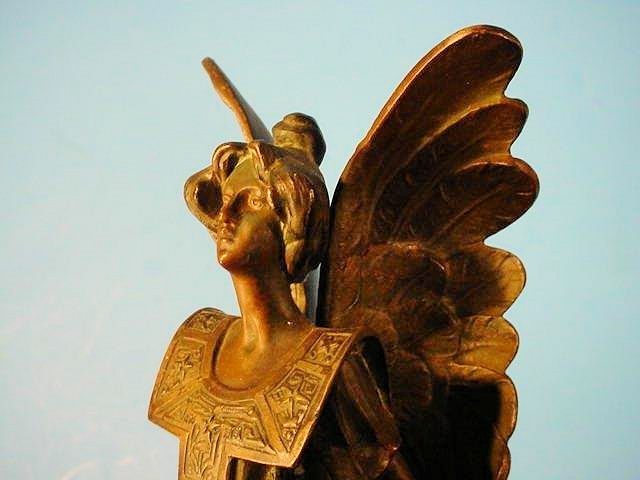
|
|
Beautiful Art Nouveau Sculpture
(Item BRONZEMET 3-10)
|
|
DESCRIPTION: Here is an item that normally would not be included in our gallery because it has no military or warfare connection. However, I could not resist its beauty and wonderfully flowing lines. It is truly a great art nouveau sculpture in the classic sense. The female figure stands in all her glorious beauty while wearing a gown of regal distinction. She also has as part of her physiognomy a pair of long, graceful wings making her a mythological figure of saga. Her hair style is typical of the 1880s. She stands about nine inches tall and that would be the measurement from the tip of the wings as they extend below the plinth. The plinth is about two inches tall comprised of two separate but joined pieces of beautiful black Italian marble. This is a very gorgeous sculpture of the 19th century.
PRICE: $450.00
|
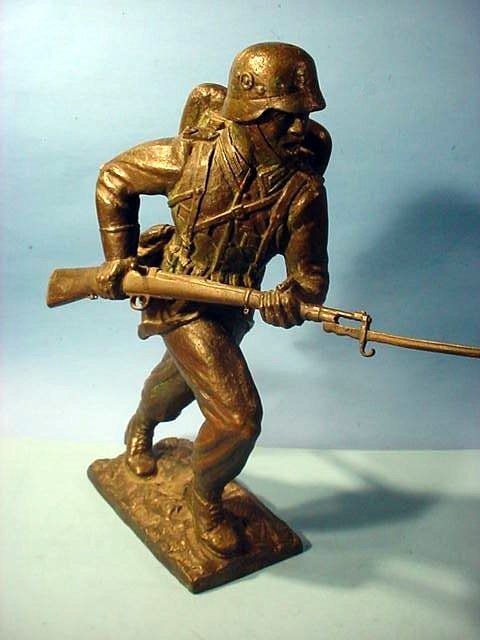
|
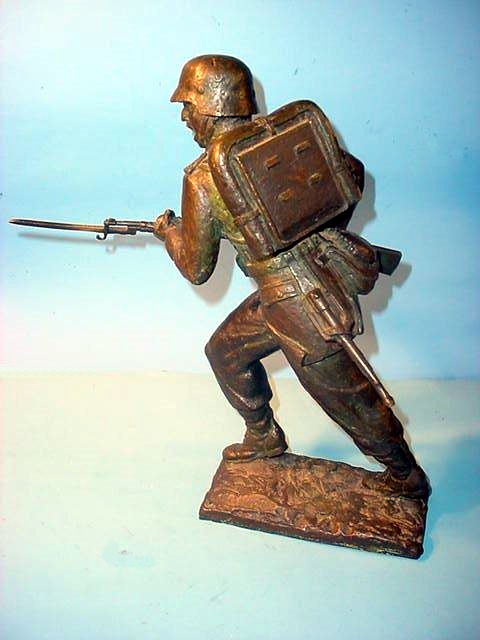
|
|
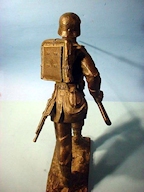
|
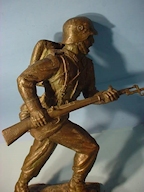
|
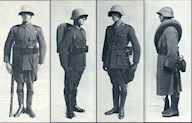
Note the similarity between these Argentine uniforms and the German's
|

Germanic right down to the goose step
|
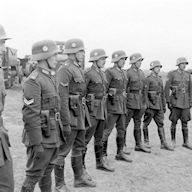
Yes, these are Argentine soldiers, not Wehrmacht
|
Charging German-Type Soldier in Bronze (Item BRONZEMET 3-11; WEHR 33-5) |
| DESCRIPTION: Why do I say “type”? Because he is not a German WWII soldier at all; he is an Argentine soldier. Under the Perón regime the Argentine army patterned its entire armed forces after the German Wehrmacht. The helmet on this sculpture is much like the German style. The tunic, field pack, ammo pouches, collar tabs, and shoulder boards are all similar to the German counterparts. The shoes are similar to the ones worn by the German Africa Corps. He has a Mauser model 98 rifle, but only the bayonet is different. It looks like a Japanese bayonet, actually. However, at an earlier point in German military history they did have a bayonet like this. The entrenching shovel, canteen, and bread bag are virtually identical to German WWII issue. Overall, it is a fact that the average person who knows a little about WWII would take this figure to be a soldier of the Deutsches Vaterland. The figure stands 16 inches. The base is measures 7 ½ x 4 inches. The length of the rifle and bayonet measure 13 inches long. This is a very dramatic sculpture, and will look great on your desk or your display case. We offer this wonderful bronze for a most reasonable price.
PRICE: $1,200.00 |
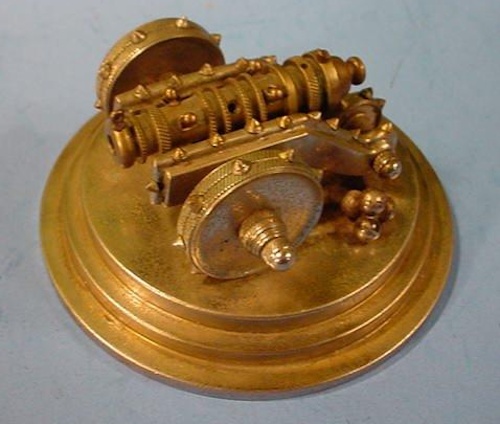
|
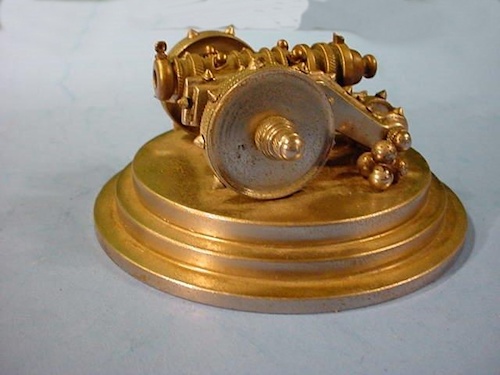
|
(Handmade) Miniature Cannon in Bronze (Item BRONZEMET 3-12) |
| DESCRIPTION: Here is the cutest little cannon you will ever see. It looks like the field piece known as the Tsar Cannon which, in its day, was the largest Howitzer ever made at the end of the Middle Ages. Don’t sell this little guy short. He is really a masterpiece of bronze art lovingly fashioned by the hands and skills of a real artist. We show several angles of the artillery piece and you can definitely see the artistry that went into this small, but dynamic, perception. It is very solid with not one loose piece or connection. The wheels are absolutely phenomenal, having spikes to hold the gun firmly to the ground when firing. It measures 4 inches in diameter at the base. The barrel length is 2 1/2 inches as is the carriage. Imagine this as your desk paperweight. You will surely hear many welcome comments on your taste in refined aesthetics. This is a charmer and certainly unique. It has only the initials of the artist under the base. It was made many years ago and the artist may be long gone, but he left behind an absolutely great little memento of his art.
PRICE: $350.00; for a unique, original piece of history personified |
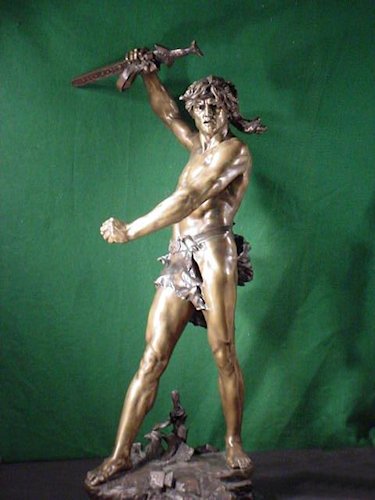
|
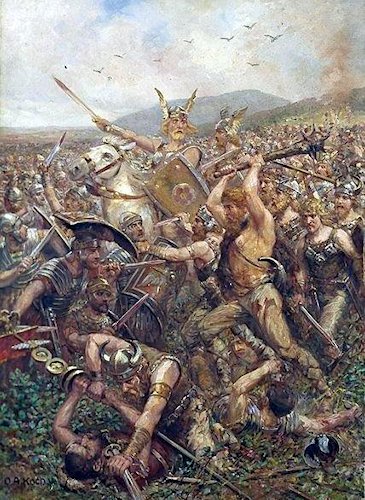
Otto Albert Koch's painting of Schlacht im Teutoburger Wald 1909
|
|
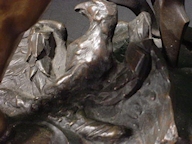
The eagle from the
fallen Roman standard
|
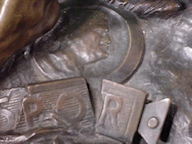
The Roman standard and emperor
|
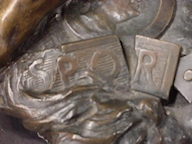
|
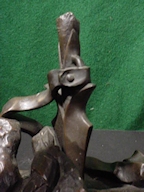
Broken Roman lance
|
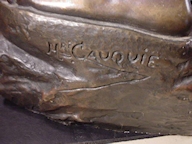
H. Gauquié's signature
|
|
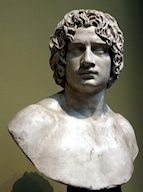
Many historians believe this
is the bust of Arminius
|

Autumn in the Teutoburger Wald
|
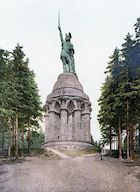
Ernst Bandel’s magnificent statue of
the liberator in the forest
|
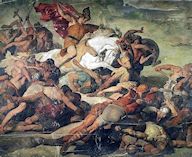
The victorious advance of Hermann
|
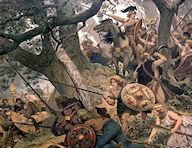
The glory of the Teutons
|
Bronze Sculpture of a Teutonic Warrior by Henri Désiré Gauquié (Item BRONZEMET 3-13; OLD 7-2a; ART 16-1a) |
DESCRIPTION: Here is what I would have to say is the sculpture that is my favorite of all the magnificent bronzes that we have ever acquired or owned in our personal collection. The subject is known as “Vae Victus” by famed sculptor Henri Désiré Gauquié (1858-1927). Born in the ancient French village of Flers-lez Lille, Henri Gauquié is well known for producing a number of small bronze statues and a large number of life-size monuments of people and animals in France. One of his famous horse sculptures is the equestrian statue of Marshal de Villens in Denain, a town between Lille and Valenciennes. It commemorates the Marshal’s victory at the Battle of Denain on 24 July 1712. A well-known monument to the French Baroque painter Jean-Antoine Watteau was created by him in 1896 in the Jardin du Luxembourg in Paris as collaboration in marble and bronze with the architect Henri Gillaume. Henri Gauquié died in Paris in 1929. He was certainly one of the finest and greatest sculptors that France ever produced and it was certainly the nation of sculptors.
The Sculpture
The depiction here by Gauquié is of a warrior of the Teutonic tribe known as the Cherusci, which, under the brilliant leadership of the chieftain Arminius, or Hermann, ambushed and decisively annihilated three Roman legions and auxiliaries which were led by Publius Quinctilius Varus. Varus was a noble from a patrician family which was related to the Imperial family. Varus’ name and deeds were well known beyond the Roman Empire because of his ruthlessness and crucifixion of insurgents. While he was feared by the people he was highly respected by the Roman Senate. On the Rhine he was in command of the XVII, XVIII, and XIX Legions. The great and bloody battle ensued after Varus attempted to enter and raid the Germania territory east of the Rhine River. After the tremendous loss during the Schlacht im Teutoburger Wald, the Battle of the Teutoburg Forest, the Roman Legions never again attempted to conquer the people in the east of the Rhine. Arminius was the son of the Cheruscan chief Segimerus and trained as a Roman military commander. He had lived in Rome as a hostage in his youth where he received a military education and obtained Roman citizenship and the status of equestrian knight before returning to Germania and defeating the Romans and after seeing to the unity of the Germanic tribes and to thwart Roman efforts to incorporate the German lands into the Empire. Then, in the year 9 AD, the Romans fell into a trap and ambush set by this ex-soldier of Rome who was still loyal to his original people. Twenty thousand of Rome’s finest soldiers were totally annihilated. Their commander, Varus, committed suicide by falling on his sword. Arminius’ success in destroying three crack legions and driving the Romans out of Germany was the single most devastating defeat that Rome had ever suffered in its history and was a high point of Germanic power for centuries. Roman attempts to reconquer Germany failed in every instance. The sculpture is magnificent. I have always been an ardent admirer of the sculptor Arno Brecker and Josef Thorak who were the official sculptors of the Third Reich. Thorak always created grandiose monuments and statues intended to represent the folk life of Germany that was under the NSDAP government. These works tended to be heroic in scale up to 65 feet in height. His official works from this period included a number of sculptures erected at the Berlin Olympic Stadium of 1936. His preference was for heroic statuary of Aryan man in the neoclassical nude and seminude depictions that practically portrayed these Aryan heroes as gods upon the earth. Certainly, this was the elite of the races of man. Perhaps it is because of my love of the art of Thorak and Brecker that I am transfixed and awed by this sculpture by Gauquié because I have never seen any bronze work of art that is so reminiscent of the work of those two German masters. The style is exactly the same right to the Aryan features and general physiognomy. The Teutonic warrior triumphantly holds high the captured Roman sword (gladius) as he treads into the forest floor. At his feet is the broken Roman-eagle standard with the letters “SPQR” the meaning of which in Latin is “The Senate and People of Rome” “Senatus Populus que Romanus.” Also thrust to the ground under the Teutonic feet is a plaque with the effigy of Emperor Augustus, who was so shaken by the news of the battle’s result that he stood butting his head against the walls of his palace repeating “Quintili Vare, legiones redde!,” “Quintilius Varus, give me back my legions!” This is a very large bronze. It measures 40 inches from the bottom of the base to the hand holding the sword. The measurement from the bottom of the base to the top of the warriors head is 36 inches. This statue summons all the utter ferocity of one of the world’s greatest and most prodigiously important battles that essentially stopped the moribund Roman empire from its eastward expansion and I think it shows the mettle of the German fighting men who many centuries later would be recognized in the German WWII Wehrmacht as we now know them. This statue can be a tribute to bravery and the constant struggle for freedom for western man.
PRICE: SOLD
|
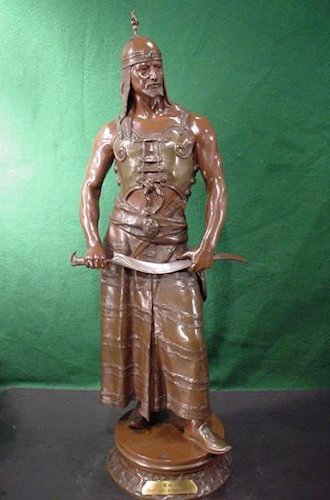
|
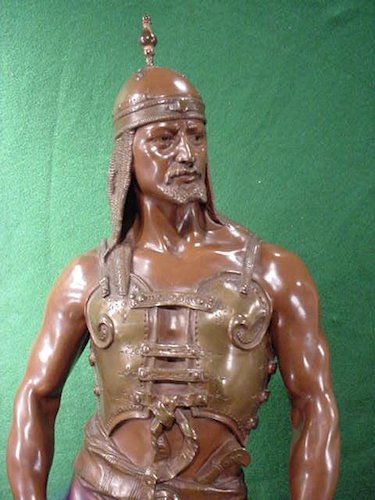
|
|
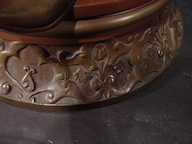
The plinth
|
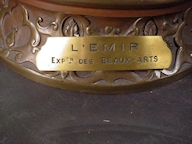
The plaque
|
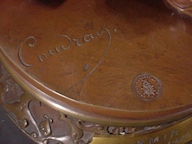
Coudray's signature
|
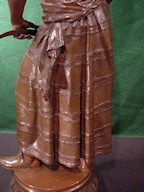
|
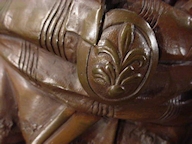
Belt buckle
|
Utterly Magnificent Bronze of the Warrior Prince l’Emir by Georges Charles Coudray (Item BRONZEMET 3-14) |
DESCRIPTION: Here is the Emir or High Sheikh. In the Arabic language it is “Emir” and means chieftain or commander and often it denoted as prince. The great Saladin was made an emir or prince in Egypt between 1174 and 1193. He defeated the Crusaders in the reconquest of Palestine at the decisive Battle of Hatton in 1187. The Crusaders had conquered it 88 years earlier. Saladin has become a prominent figure in Muslim, Arabic, and Kurdish culture and his reported noble and chivalrous behavior was noted even by Christian chroniclers and despite being the nemesis of the Crusaders, he purportedly won the respect of many of them, including Richard the Lionheart, who led the Third Crusade. This sculpture may well have represented Saladin, himself? The bronze sculpture we offer is by the famed artist Georges Charles Coudray, who was born in Paris in 1883 and died in 1932. He was considered one of the greatest French bronze sculptors during his fabulous artistic career and is still recognized as such today. He was a student of the great Parisian sculptor Jean-Joseph-Alexandre Falguière. Many of Coudray’s statues, busts, and medallions often exhibited a distinctive eastern influence. He exhibited his work at the Salon from 1883 to 1903. Among his most characteristic works was this wonderful statue of the all-high Emir and also the elegant “Aguila,” a statuette in bronze created in 1892, then, in 1899, “Les Nénuphars,” a bust in terra cotta and “Iris,” a statue in marble in 1902. However, the Emir and a statuette in plaster entitled “Tahoser” inspired by the Roman de la momie of Théophile, representing an Egyptian maiden playing the harp, were undoubtedly his greatest. The Egyptian statuette was exhibited at the Paris Salon of 1892.
The Emir Bronze
This magnificent sculpture in fire-bronze finish bears about the finest patina that we have ever observed on any sculpture to date. Its wonderful brilliance brings forth the fantastic detail that Georges Coudray painstakingly applied to his masterpieces. It is a big and heavy bronze standing 33 inches high from the bottom of the plinth to the top of the spike figuration on his helmet or Khula-khud. He holds an Arabic sword known generally as a scimitar or more exactly as the Saiful Ali, the most famous sword in Islamic history. Legend has it that the Muslim warrior Ali Zulfiker slew a Markan foot soldier with this famed sword cleaving both his helmet and head at the Battle of Uhud and at the same battle he slew Amr, a ferocious, and devastating Markan soldier in the heat of battle. The Markan people were of Negroid stock from the Sahara regions. The curved sword—scimitar—was widespread throughout the Muslim world especially in the Ottoman period. In his belt he wears a dagger that is styled like an Ottoman yataghan sword, but this one is a dagger called a Zirah-bouk. Coudray was always very accurate in portraying the weapons and clothing of these warriors of the past. The vest and robe that the Emir wears is perfectly and accurately depicted for a high official and warrior of that era. On the plinth there is a brass plaque that proclaims the title of the bronze: “L’EMIR EXPon- (the initials mean for exhibition)- - DES BEAUX-ARTS.” These three words refer to the greatest artistic style as taught at the École nationale supérieure des Beaux-Arts in Paris, the world’s most prestigious school for the training of French artists. This Coudray sculpture is considered very typically “Beaux-Arts" style. In other words, in the wonderful neoclassical style that is forever loved and adored by true art connoisseurs. And of course as we mentioned before Coudray exhibited his art at the Salon in Paris. This was the official art exhibition of the Académie des Beaux-Arts and between 1748 to 1890 it was the greatest annual art event in the Western world, where the ever-conservative and academic juries were not at all receptive to the impressionist artists (if you can call them artists). Their works were usually rejected or at least poorly placed if accepted at all, and very few were ever accepted. Realism and natural beauty in art were the order of the day and this sculpture, “L’Emir” certainly was a star attraction and I believe you can easily see why. We are very proud to offer this example of Beaux-Arts in possibly the greatest example you may ever see offered anywhere. This is surely the best!
PRICE: No longer available. |
|
|
|
Sculpture of Jeanne d’Arc, in French (Item BRONZEMET 3-15; FRAN 2-1)
|
| DESCRIPTION: This is a magnificent sculpture by the master artist by the name of Laucier of the immortal Joan of Arc. Joan was born at Domrémy in the province of Lorraine in 1412, daughter of a peasant farmer; poor, but not needy. She never learned to read or write. She was noted to be a singularly pious child, who often knelt in church absorbed in prayer. Later, the vicious English invaders tried to connect her with superstitious, witchlike practices supposed to have been performed around a certain tree popularly know as the “Fairy Tree.” She had sung and danced there with other children and she wove wreaths from its leaves and branches for the statue of the Virgin, but she was no witch. It was at the age of 13 in the summer of 1416 that this young maiden first became conscious of that manifestation whose supernatural character; it would now be rash to question. Later she was able to identify and discern in some way the voices that spoke to her. She identified St. Michael, St. Catherine, and others. She was always reluctant to speak of her voices. Nonetheless, she told the star-chamber judges, “I saw them with my own eyes just as well as I see you.” The legend has it that the voices revealed her mission and it does seem that the call of God was only made to her gradually, but by May 1428, she no longer doubted that she was to go to help the king. The military situation of King Charles and his supporters was growing more desperate. Orléans was invested October 12, 1428, and by the close of the year complete and devastating defeat seemed imminent. Joan’s voices became urgent and even threatening. She said to them, “I am a poor girl. I do not know how to ride or fight.” The voices reiterated, “It is God who commands it.” Yielding at last, she left Domrémy in January 1429, went to her king, donned male costume, took up the sword, and impressed the generals because of her persistence. A secret sign communicated to her by the voices led the king somewhat half heartedly to believe in her mission. What this mission was Joan never revealed. Her faith, honesty, and simplicity made a favorable impression. Instead of the sword that the king had given her she begged that a search might be made for an ancient sword buried as she averred behind the altar in the chapel of Ste-Catherine-de-Fierbois. It was found in the very spot her voices indicated. There was made for her at the same time a standard bearing the words: “Jesus, mama,” with a picture of God the Father, and kneeling angels presenting a fleur-de-lis. The rest is the story of how with devotion to her cause, bravery, and heavenly guidance Joan was able to lead the French Army to victory after victory literally driving the hated English from French soil and she finally saw Charles VII solemnly crowned July 17, 1429. The principal aim of Joan’s mission was thus attained and it was now her wish to return home, but the army would not hear of it. It had never loved any commander more. Finally captured at the Battle of Compiègne on May 24, she began the long road to martyrdom. No words can describe the disgraceful ingratitude and apathy of Charles and his advisors in leaving the maid to her fate. Joan was literally sold to the English by John of Luxemburg for the sum which would amount to several hundred thousands of dollars in modern money. There can be no doubt that the English, partly because they feared their prisoner with a superstitious terror, and partly because they were ashamed of the dread she inspired, were determined at all costs to take her precious life. They could not put her to death for having beaten them, but they could get her sentenced as a witch and a heretic. She suffered bestial treatment from the English and traitors from her French countrymen such as Pierre Cauchon, the bishop of Beauvais. She was kept in an iron cage chained by the neck, hands, and feet, and allowed no spiritual privileges. We will not recount the infamous star-chamber court proceeding. The whole affair was cruel beyond belief with the English and Burgundians furiously tormenting her. When they finally had their way a court of 37 judges (murderous stooges) decided unanimously that the maid must be treated as a relapsed heretic. On May 30, 1431, amid circumstances of intense pathos she was allowed to receive communion and make her confession. Her demeanor at the stake was such to move even her bitter enemies to tears. She asked for a cross, which after, she embraced it, was held up before her while she called continuously upon the name of Jesus. “Until the last,” said Manchon, the recorder at the trial, “she declared that her voices came from God and had not deceived her.” After death her ashes were thrown into the Seine. Joan was canonized as a saint in 1920 by Pope Benedict XV. This sculpture captures all the noble countenance of this maid of Orléans more than any of such statuary that we have seen over the years. The detail is extraordinary and even this Lutheran has to greatly admire not only the wonderful artwork, but the saga of this the bravest and most noble of the Saints of Catholicism. Yet this is more than a statue of a saint; it is the artistic expression in bronze of an idea! The indomitable spirit of loyalty and a love of country and creed all summed up in the depiction of Joan, Maid of Orléans. The sculpture measures about 17 1/2 inches from the bottom of the base to the top of the head, 19 1/2 inches from the bottom of the base to her outstretched hand, 23 1/4 inches from the bottom to the spear tip of her standard. The base is about 5 1/2 inches and is basically square. The standard is inscribed with “Maria” and the kneeling angels. The sword bears the fleur-de-lis. This is a museum-grade sculpture worthy of the finest collection. We are proud to offer it on Germania’s pages.
PRICE: SOLD
|
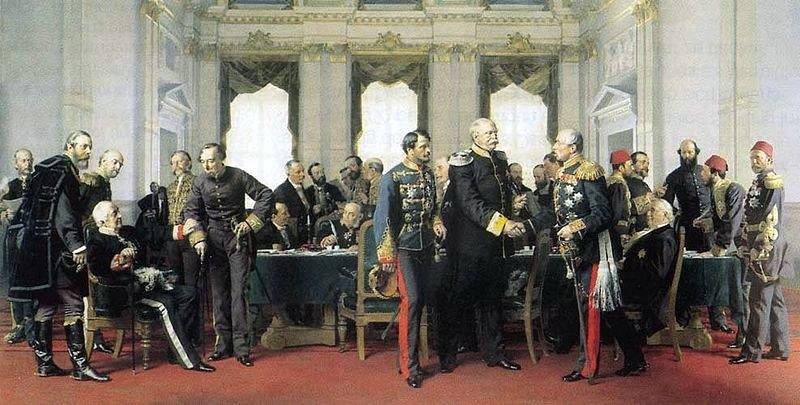
Bismarck at Versailles
|
|
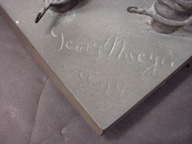
Artist's signature
|
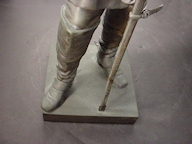
|
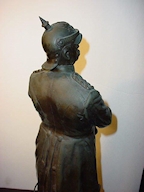
|
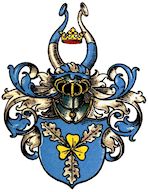
Coat of arms of the Bismarck family
|
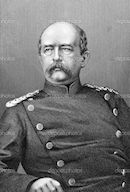
|
|
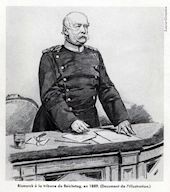
The great German statesman
|
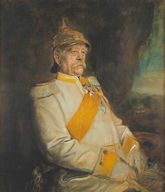
The most famed portrait of Bismarck
|
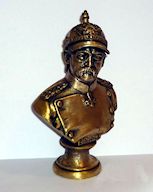
A bust of Otto von Bismarck
|
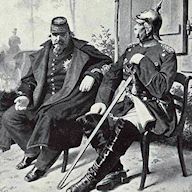
Prince von Bismarck accepts the surrender of Napoleon III in 1870
|
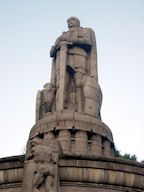
Another gigantic statue of Bismarck in Germany
|
|
|
Statue of Prince Otto von Bismarck (Item BRONZEMET 3-16; KSTATUE 5-19)
|
DESCRIPTION: Here is one of the very best likenesses of the famous Iron Chancellor of Germany I have ever seen. Possibly, it is not the most glamorous, but certainly it is one of the most true-to-life depictions of the Man of Iron that we have ever seen. The firm and powerful countenance is apparent as he stands proudly and defiantly against all odds and self-assured of his agenda of unifying the German states into the German nation along with Kaiser Wilhelm I of Prussia. Together they radically and boldly brought about this their dream and managed to make it a reality after Prussia’s fabulous victory over France in 1870. Bismarck was absolutely the greatest statesman who ever dominated German and European affairs with his conservative policies from the 1860s until Kaiser Wilhelm II forced his resignation in 1890. It was at the close of the above-mentioned war with Napoleon II of France that he unified most of the German states into the powerful German empire under Prussian leadership. He then created a balance of power that preserved peace in Europe from 1871 until 1914. Otto von Bismarck became the first chancellor of a united Germany after the Treaty of Versailles and largely controlled its affairs until his dismissal in 1890. His diplomacy of real politick and his powerful leadership gained him the nickname “The Iron Chancellor.” Bismarck as a devout Lutheran was loyal to his king, Wilhelm I, who, in turn gave Bismarck his full support. Bismarck distrusted democracy and ruled through a strong, well-trained bureaucracy with the power in the hands of Junker elite representing the landed aristocracy in the east. Bismarck, an aristocratic Junker himself, had an extremely aggressive and domineering personality. Bismarck became a hero to German nationalists who built hundreds of monuments glorifying the iconic symbol of powerful conservative leadership. Historians generally praise him as a statesman of balance who kept the peace in Europe and was primarily responsible for the unification of the Fatherland. Much can be found regarding this “Enormen” or “giant” on Wikipedia. If he was not a giant in stature he certainly is thought to be one in his entire stance in the cause of his nation, his king, and his German Volk. If the truth were known regardless of whose ox is gored and one had to decide who were the greatest leaders of Germany, the names that come forth would surely be Frederick the Great, Bismarck the Iron Chancellor, and the Führer Adolf Hitler. All kinds of dubious accusations can be hurled at all three, but the fact is they were—all three of them—Germany’s greatest, elite leaders. Bismarck once said, “The more I know of men the more I love my dog!” I tend to agree!
The Statue!
The statue stands about two feet high and is in heavy bronze or possibly it is in iron. Can’t really tell because the patina certainly looks like iron. Wouldn’t that be rather apropos seeing that the figure is after all the Iron Chancellor, isn’t it? This statue was bought out of an estate of an old aristocratic German family who settled in the Philadelphia area and when the last of the line died out, this wonderful figure was sold out of the estate to a local antique dealer who in turn sold it to us. The statue is in remarkably fine condition having been carefully preserved over many years there in Philly. The sculpture is absolutely fine and the likeness to the elder statesman is phenomenal, indeed. It’s almost impossible to imagine after all those years that the spike on his Pickelhaube and his sword straps are 100-percent intact and have never been replaced. Even the most delicate items on the sculpture are intact and that would be the spurs on his boots. Consider all this because usually these items would be missing, repaired, or replaced. This statue had obviously experienced tender-loving care! He wears the Order of Hohenzollern or the Black Eagle of Prussia at his collar and the Iron Cross First Class on his coat. His dragoon helmet and his shoulder boards are correctly portrayed; his frock coat shows all the correct wrinkles and folds. The artist did sign his name on the short plinth that the chancellor stands on. I admit I can’t make out the signature, but the artist must have been one of the greats because this is a very wonderful likeness that he has created. So, here is your personal memorial to this great man of destiny–Otto von Bismarck.
PRICE: SOLD
|
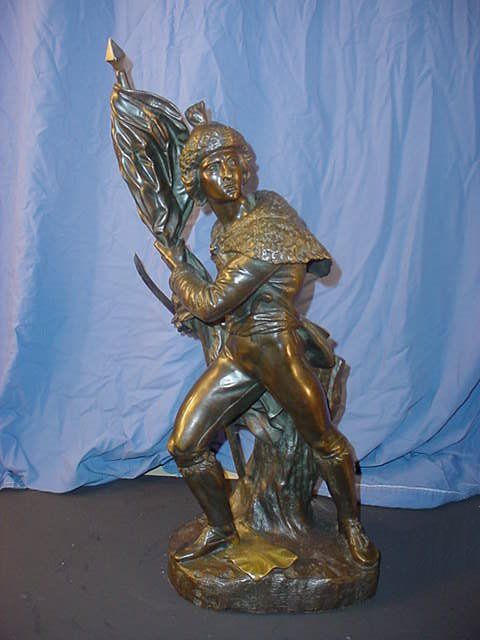 |
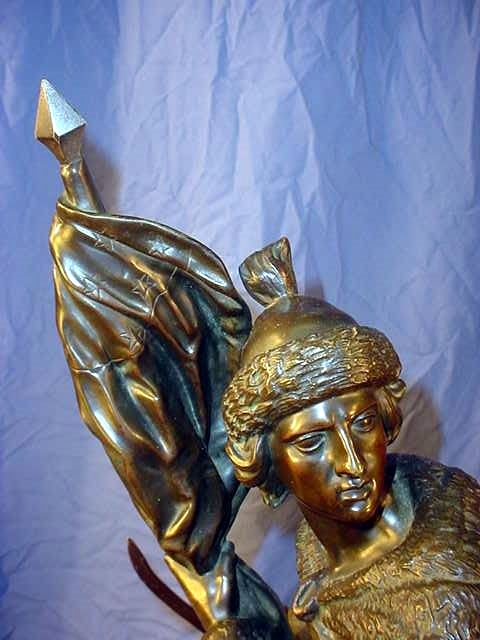 |
| 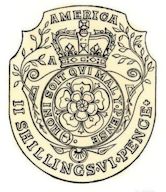
The Stamp Act seal
|
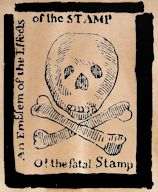
Poster depicting how the colonists felt about the act
|
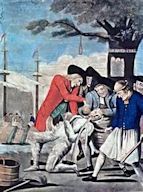
Tarring and feathering a revenuer
(a good Idea even today!)
|
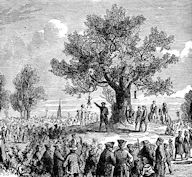
The effigy and the British boot hanging in the Liberty Tree
|
| 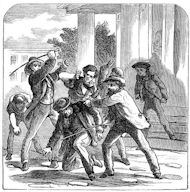
Stamp Act official beaten by patriots
|
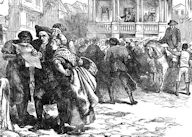
Reading the Stamp Act
|
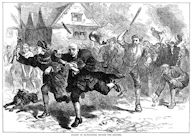
“Hang the tax-collector bastards!”
|
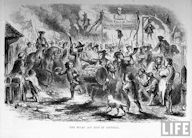
Note the liberty cap on a pole in the picture
|
Original Bronze Sculpture of an American Revolutionary Patriot who Undoubtedly Belonged to the “Sons of Liberty” (Item BRONZEMET 3-18; USARTICLES 3-7)
|
DESCRIPTION: Here is possibly one of the most important historical bronzes we have ever obtained depicting one of our American epochs of glory.
(In my opinion the American Revolutionary War and the subsequent War of 1812 were the only wars that the nation fought that were morally and ethically acceptable!)
This very dramatic statue depicts one of the prerevolutionary patriots who surges forward in the cause of liberty while stepping on the infamous Stamp Act. The bronze sculpture is very heavy seemingly of solid bronze. It is also a fairly large piece–28 ½ inches high. The figure holds his sword, commonly called a ‘hanger’ or short sword, in one hand ready for battle and in the other he holds the American flag that for him is the holy ensign. The flag is held unfurled, but at the ready to be cast forth in full display in the cause of liberty. The man wears the revolutionary cap so reminiscent of the times and the cause. Behind him is the stump of the tree that was all that remained from 1775 after the British felled it. The tree stood in Boston near Boston Common in the days before the American Revolution, 1776-1783. In 1765, colonists in Boston staged the first act of defiance against the British government at the tree. The tree then became a rallying point to the rule of Britain over the American colonies and it was for this reason that prompted the British soldiers to cut it down. However, it can never be forgotten that in a letter to a fellow patriot, Thomas Jefferson said: “The tree of liberty must be refreshed from time to time with the blood of patriots and tyrants.” It is a fact of American history that on 14 August 1765, a crowd gathered in Boston under the large elm tree at the corner of Essex Street and Washington Street to protest the hated Stamp Act. Patriots, who later called themselves the Sons of Liberty, had hanged Andrew Oliver in effigy in the branches of the tree. Oliver was the colonist chosen by King George III to impose the Stamp Act and right up there in the tree along with the effigy hung a British cavalry jackboot. Grinning from inside the boot was a devil-like doll holding a scroll marked “Stamp Act.” On 10 September, a sign saying “Tree of Liberty” was nailed to the trunk of the tree. On the bronze statue offered here is a scroll marked “Stamp Act” and is seen at the feet of our patriot Colonist soldier, and behind him is seen the stump of the Tree of Liberty. This sculpture is not signed. Why? we do not know for it truly is a wonderful depiction of American resolve and independence. It had to be by a masterful sculptor indeed. The drama and historical excellence is most noteworthy. We have dealt in bronze statuary for decades and have never seen a first-class sculpture depicting this glorious and turbulent era. Here is a true rarity that serves as a fitting memorial to supreme patriotism and courage of those brave men who risked their property and even their lives in the cause of freedom. Would that we could see such men step forward now that America so desperately needs them.
PRICE: P.O.R. |
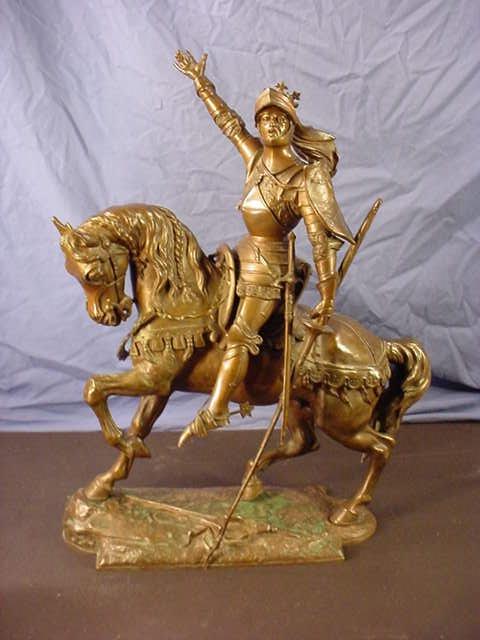 |
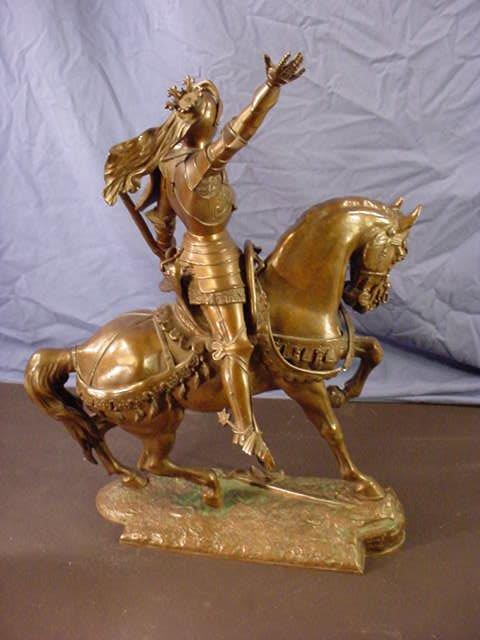 |
Bronze of Jousting Victor (Equestrian Knight) (Item BRONZEMET 3-19)
|
DESCRIPTION: Here is a magnificently detailed bronze of an armored knight who has just defeated his opponent in a jousting tournament. He raises his arm in the traditional victory salute to the royal grandstand box that usually was attended by the royal personages. Those often included the king, queen, and the lovely maiden who customarily placed the crown that you see in our pictures upon his helmet. This was done ceremonially at the conclusion of the event. The sculpture is by Émile Guillemin (1841-1907) known by the art world as a master sculptor renowned for his small, but beautifully rendered figures of cavaliers, conquistadors, and knights and often seen in competition or combat. (We have a magnificent pair of duelers with swords at the ready on this page above at BRONZEMET 3-4.) Guillemin was born in Paris and enjoyed sculpting some of the finest of bronze and white-metal figures ever cast with accurate costuming, minute detailing with expressive faces, and tip-top French foundry work always typify his sculptures. It can be said without hesitation that he was one of the finest and most lauded of all French sculptors. The interesting subject matter of this Guillemin bronze that we offer makes it a very special piece. Jousting was a martial game between two horsemen each wielding a long lance with a blunted tip often as part of a medieval tournament. The primary aim is to strike the opponent with the jousting lance while riding towards him at high speed and if possible breaking the lance on the opponent's shield or jousting armor and unhorsing him. Jousting emerged in the high middle ages based on the military use of the lance by heavy cavalry. It transformed into a specialized sport during the late Middle Ages and remained popular with the nobility in England and Germany throughout the whole of the 16th century (while in France it was discontinued after the death of King Henry in a tournament accident in 1559). In England jousting was the highlight of the accession-day tilts of Elizabeth and James I and also was part of the festivities at the marriage of Charles I. The joust became an iconic charismatic event of the knight in romantic medievalism and hence in the depiction of the Middle Ages in popular cultures. Jousting matches were notably depicted in the novel Ivanhoe (1820).
The Bronze
The piece is larger than the usual sculptures of Émile Guillemin. From the base it measures 20 inches to the top of his extended hand. The length is 14 inches. The base is 12 inches x 5 ½ inches. The knight is mounted on a great steed that has all the correct trappings of the tournament horse. The knight wears on his helmet the Crown of Victory as explained before. He bears a shield upon which is depicted a knight errant riding into battle. (Perhaps it is a self-image). From his helmet behind the crown waves a long scarf-like fabric that very well could have been an additional trophy of the day from a beautiful lady (possibly the princess). All the armor and saddle is true to the time. He still has the jousting lance in his armor mail glove and it hangs downward by his side. The lance of the defeated opponent is seen broken and lying under the feet of the victory horse. So perfect is the condition of this bronze that even the knight's spurs and his exposed sword are all there (so rare in this type of antique sculpture). All in all we feel that this might just be the finest bronze art piece we have ever offered; it’s hard to imagine a better one! When it comes to this remarkably fine patina, detailing and vibrant action in its subject matter it seemingly illustrates the fact that Guillemin outdid even himself in this glorious portrayal of wonderful grandiose romantic medieval history.
PRICE: SOLD
|
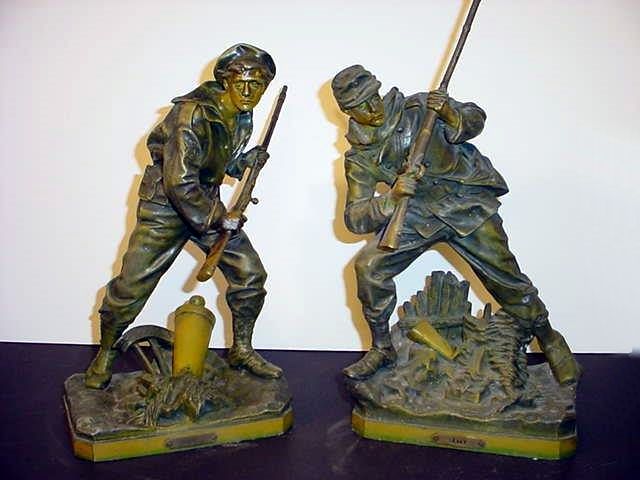 |
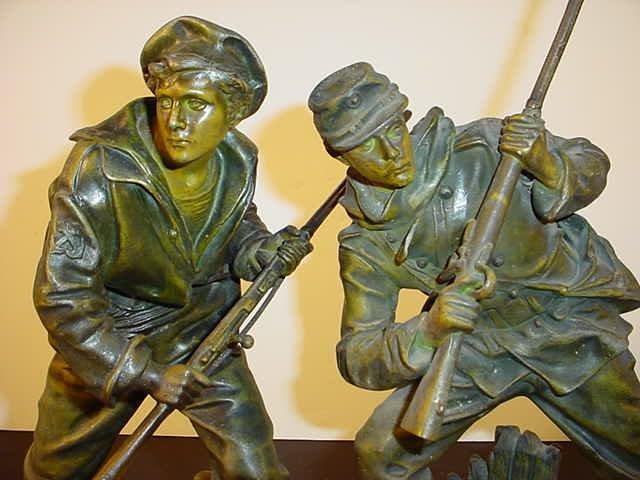 |
|
Pair of Soldier and Sailor Figures (French 1870) (Item BRONZEMET 3-20; FRAN 4-17)
|
| DESCRIPTION: Here are two action figures probably done in the early 1870s just before the Franco-Prussian War. They were cast in metallic zinc or white metal. Whenever rarely this pair shows up in an antique show or shops invariably one of them is missing or when they are found together the rifle barrels at least will be missing because of the fragile positions they were manufactured in. Ours are practically perfect except for a rifle sling with the soldier. They are, when found, practically always labeled “American Civil War Figures” and priced very dearly missing parts or not. The French uniforms at that time were in fact copied from the American-issued battle dress of the 1860s and France used this sort of military attire until its defeat by the victorious Prussians in the Franco-Prussian war of 1870. We offer these figures for what they really are and that is two magnificent artistic figures of a soldier and sailor of the French armed forces as depicted during that early time of warfare. They are both shown wearing the correct uniforms of the period and their action stance is clearly dramatic; they stand about 13 inches high including their bases. The bases measure 5 x 7½ inches. There are no signatures, but it’s obvious they were the original design by a master sculptor. The bases identify them as “Army” and “Navy” by small plaques (To a greater part, these were made for export and sold in French stores to tourists from England and the U.S.A.). Think of these as added to that bookcase behind your office desk. They are really and truly pure classic art!
PRICE: SOLD
|
|
|
|
Walkurie Bronze and bone by Claire Jeanne Roberte Colinet, 1880-1950 (Item BRONZEMET 3-22; ART 15-7; FRAN 3-9) |
|
| DESCRIPTION: If you seek a reminder of the 1920s age of streamlined sophistication then look no further to the bronze figures produced through the 1920s and 1930s. Lithe, limbered, scantily draped, or fully nude beautiful young woman posed in theatrical, athletic or historical costuming found their way into the modern interiors of the aspiring upper-class homes. Among the greatest sculptresses of the period was Claire Jeanne Roberte Colinet, who was born in Brussels at the end of the 19th century. She trained as a pupil of the Belgian naturalistic sculptor Jeff Lambeaux. She had exhibited her works at the Salon des Artistes Français in Paris for over 40 years. She made her debut there in 1913 and obtained mention of honor. In 1914 moreover between 1937 and 1940, her sculptures were also shown at the Salon des Indépendents. She indeed was the master artist in creating sculptures. She regularly incorporated theatrical themes personified by her dancers of the world groupings. No doubt this magnificent Colinet that we offer here was inspired by the “Ride of the Walkuries” by Richard Wagner in his great “ring” cycle. We would lean toward calling this sculpture “Walkurie,” but it is well known in the finest of art circles as (Towards the Unknown). The one we offer is in perfect condition with the usual age cracks here and there. The figure is about 19 inches high and 15 inches from the end of the horse’s tail to his snout. I understand that this figure was done in two sizes and the one we have is the big one. To call this piece rare would be wildly understating it. This is “super rare” and a highly desirable art bronze actively sought by collectors worldwide. We will give the Germanophiles a chance at it for what has to be a limited amount of time and then the consigner will probably put it at auction more than likely at Sotheby’s. This particular sculpture is so popular that you will find that several dealers offer posters depicting this rider listed as (Towards the Unknown). This poster is advertised from dealers in dozens of countries. The statue is respected and beloved, indeed, in the world of realistic art.
PRICE: SOLD
|
Contact Us
Please refer to item designator in parentheses in all correspondence.
Please E-mail for any additional information you may need.
If you prefer, contact 'Germania' at PO Box 68, Lakemont, GA 30552
or call at 706.782.1668.
Please! do not call during the wee hours of the morning. The best time for calling us is between 9 and 11 am and between 9 and 11 pm
eastern time.
| |

![]()
